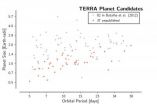(Press-News.org) Breast and colorectal cancer screening should be targeted towards patients with a life expectancy greater than 10 years: for any shorter life expectancy the harms are likely to outweigh the benefits, concludes a study published on bmj.com today.
The authors stress that their results "should not be used to deny screening for patients with limited life expectancy" but "should inform decision making which aims to account for patient preferences and values while maximising benefits and minimising risks."
Guidelines recommend screening healthy older patients because complications from screening can harm patients immediately while the benefits of screening are not seen for many years.
What still remains unclear, however, is how long a patient needs to live to benefit from cancer screening. Previous trials have focused on the size of benefit rather than when those benefits occur.
Researchers from the University of California in San Francisco therefore analysed the results of five breast and four colorectal cancer screening trials focusing on patients aged over 50.
Their goal was to estimate the time-lag to benefit (the time between screening and when the benefits of screening are seen) to determine whether an individual patient is likely to benefit from screening.
The trials were published between 1986 and 2008 and ranged in size from just under 40,000 people to just over 150,000 people. Follow-up ranged from 8-20 years.
Results showed that at five years, an average 2.8 colorectal cancer deaths were prevented for every 10,000 people screened. This benefit steadily increased with longer follow-up, reaching 23 colorectal cancer deaths prevented for every 10,000 people screened at 15 years.
In absolute terms, it took an average of 4.8 years to prevent one colorectal cancer death for 5,000 people screened and 10.3 years to prevent one death for 1,000 people screened.
For breast cancer, at five years an average of 5.1 deaths were prevented for every 10,000 women screened. By 15 years, this mortality benefit had increased to 19 breast cancer deaths prevented for every 10,000 women screened.
In absolute terms, it took an average of three years to prevent one breast cancer death for 5.000 women screened and 10.7 years to prevent one death for 1,000 women screened.
However, the researchers say that in both colorectal and breast cancer, approximately one in ten people screened will have a false positive result and many more will be subject to possibly unnecessary treatment.
Based on these results, they suggest that patients with a life expectancy greater than ten years "should be encouraged to undergo colorectal and breast cancer screening" but patients whose life expectancy is 3-5 years "probably should be discouraged from screening since the potential risks likely outweigh the very small probability of benefit."
They conclude that incorporating time lag estimates into screening guidelines "would encourage a more explicit consideration of the risks and benefits of breast and colorectal cancer screening, likely resulting in a more individualised decision making process for the heterogeneous population of older adults."
###
Research: Time-lag to benefit after screening for breast and colorectal cancer: meta-analysis of survival data from the United States, Sweden, United Kingdom and Denmark
Cancer screening unlikely to benefit patients with a short life expectancy
Less than 10 years and risks are likely to outweigh benefits
2013-01-09
ELSE PRESS RELEASES FROM THIS DATE:
BMJ raises concerns over the effectiveness of a costly and invasive procedure for melanoma
2013-01-09
A special report published by the BMJ today finds that thousands of melanoma patients around the world are undergoing an expensive and invasive procedure called sentinel node biopsy, despite a lack of clear evidence and concerns that it may do more harm than good.
Although not recommended for routine use in England, it has become the standard care for melanoma patients in several countries including the United States, where it was estimated to cost over $686m in 2012.
Melanoma is the fifth most common cancer in the UK, affecting one in 60 people. In the US it affects ...
Reduction in air pollution from wood stoves associated with significantly reduced risk of death
2013-01-09
Male deaths from all-causes, but particularly cardiovascular and respiratory disease, could be significantly reduced with a decrease in biomass smoke (smoke produced by domestic cooking and heating and woodland fires), a paper published today on bmj.com suggests.
The researchers say this could have significant impact on further interventions to reduce pollution from this source.
Although a large amount of research has been carried out on the adverse health effects of air pollution, no studies have reported reductions in deaths associated with interventions to reduce ...
First oral drug for spinal cord injury improves movement in mice, study shows
2013-01-09
COLUMBUS, Ohio – An experimental oral drug given to mice after a spinal cord injury was effective at improving limb movement after the injury, a new study shows.
The compound efficiently crossed the blood-brain barrier, did not increase pain and showed no toxic effects to the animals.
"This is a first to have a drug that can be taken orally to produce functional improvement with no toxicity in a rodent model," said Sung Ok Yoon, associate professor of molecular & cellular biochemistry at Ohio State University and lead author of the study. "So far, in the spinal cord ...
Synthetic 'poop' can cure C. difficile infection, study finds
2013-01-09
A synthetic "poop" developed at the University of Guelph can cure nasty gastrointestinal infections caused by Clostridium difficile, a toxin-producing bacterium.
A study on the artificial stool was published today in the inaugural issue of Microbiome, a new peer-reviewed science journal.
The stool – a "super-probiotic" called RePOOPulate – was created by Guelph microbiologist Emma Allen-Vercoe to replace human fecal matter used in stool transplants, a known treatment for C. difficile.
She made the super-probiotic from purified intestinal bacterial cultures grown ...
Earth-size planets common in galaxy
2013-01-09
An analysis of the first three years of data from NASA's Kepler mission, which already has discovered thousands of potential exoplanets, contains good news for those searching for habitable worlds outside our solar system.
It shows that 17 percent of all sun-like stars have planets one to two times the diameter of Earth orbiting close to their host stars, according to a team of astronomers from the University of California, Berkeley, and the University of Hawaii at Manoa.
This estimate includes only planets that circle their stars within a distance of about one-quarter ...
'Tricorder' invention could put medical diagnosis and terrorism prevention in the palm of the hand
2013-01-09
COLUMBIA, Mo. -- The hand-held scanners, or tricorders, of the Star Trek movies and television series are one step closer to reality now that a University of Missouri engineering team has invented a compact source of X-rays and other forms of radiation. The radiation source, which is the size of a stick of gum, could be used to create inexpensive and portable X-ray scanners for use by doctors, as well as to fight terrorism and aid exploration on this planet and others.
"Currently, X-ray machines are huge and require tremendous amounts of electricity," said Scott Kovaleski, ...
'Universal' personality traits may not be universal after all
2013-01-09
(Santa Barbara, Calif.) –– For decades, consensus among psychologists has held that a group of five personality traits –– or slight variations of these five –– are a universal feature of human psychology. However, a study by anthropologists at UC Santa Barbara raises doubt about the veracity of that five-factor model (FFM) of personality structure as it relates to indigenous populations. Their findings appear in the current issue of the American Psychological Association's Journal of Personality and Social Psychology.
Studying the Tsimane, an isolated indigenous group ...
Counting the twists in a helical light beam
2013-01-09
Cambridge, Mass. - January 8, 2013 - At a time when communication networks are scrambling for ways to transmit more data over limited bandwidth, a type of twisted light wave is gaining new attention. Called an optical vortex or vortex beam, this complex beam resembles a corkscrew, with waves that rotate as they travel.
Now, applied physicists at the Harvard School of Engineering and Applied Sciences (SEAS) have created a new device that enables a conventional optical detector (which would normally only measure the light's intensity) to pick up on that rotation.
The ...
New marker of drug response may speed pace of lung cancer prevention trials
2013-01-09
Testing medicines to prevent lung cancer requires treating many thousands of high-risk individuals and then waiting 5, 10 or 15 years to discover which of them develop cancer and which, if any, experience survival benefit from the treatment. A University of Colorado Cancer Center study recently published in the journal Cancer Prevention Research proposes a possible waypoint on the way to benefit, which if validated, could dramatically reduce the number of patients needed and time required to test drugs for lung cancer prevention.
"Chemoprevention is an important approach ...
Battle of the sexes: Who wins (or loses) in ACL ruptures?
2013-01-09
ROSEMONT, Ill.—Female athletes are three times more likely to suffer from anterior cruciate ligament (ACL) ruptures, one of the most common knee injuries, compared to male athletes. The ACL is one of the four main ligaments within the knee that connect the femur (upper leg bone) to the tibia (lower leg bone). Recent research highlights the unique anatomical differences in the female knee that may contribute to higher injury rates, and should be taken into consideration during reconstructive surgery and sports training, according to a review article in the January 2013 issue ...
LAST 30 PRESS RELEASES:
Sleeping in on weekends may help boost teens’ mental health
Study: Teens use cellphones for an hour a day at school
After more than two years of war, Palestinian children are hungry, denied education and “like the living dead”
The untold story of life with Prader-Willi syndrome - according to the siblings who live it
How the parasite that ‘gave up sex’ found more hosts – and why its victory won’t last
When is it time to jump? The boiling frog problem of AI use in physics education
Twitter data reveals partisan divide in understanding why pollen season's getting worse
AI is quick but risky for updating old software
Revolutionizing biosecurity: new multi-omics framework to transform invasive species management
From ancient herb to modern medicine: new review unveils the multi-targeted healing potential of Borago officinalis
Building a global scientific community: Biological Diversity Journal announces dual recruitment of Editorial Board and Youth Editorial Board members
Microbes that break down antibiotics help protect ecosystems under drug pollution
Smart biochar that remembers pollutants offers a new way to clean water and recycle biomass
Rice genes matter more than domestication in shaping plant microbiomes
Ticking time bomb: Some farmers report as many as 70 tick encounters over a 6-month period
Turning garden and crop waste into plastics
Scientists discover ‘platypus galaxies’ in the early universe
Seeing thyroid cancer in a new light: when AI meets label-free imaging in the operating room
Neutrophil-to-lymphocyte ratio may aid risk stratification in depressive disorder
2026 Seismological Society of America Annual Meeting
AI-powered ECG analysis offers promising path for early detection of chronic obstructive pulmonary disease, says Mount Sinai researchers
GIMM uncovers flaws in lab-grown heart cells and paves the way for improved treatments
Cracking the evolutionary code of sleep
Medications could help the aging brain cope with surgery, memory impairment
Back pain linked to worse sleep years later in men over 65, according to study
CDC urges ‘shared decision-making’ on some childhood vaccines; many unclear about what that means
New research finds that an ‘equal treatment’ approach to economic opportunity advertising can backfire
Researchers create shape-shifting, self-navigating microparticles
Science army mobilizes to map US soil microbiome
Researchers develop new tools to turn grain crops into biosensors
[Press-News.org] Cancer screening unlikely to benefit patients with a short life expectancyLess than 10 years and risks are likely to outweigh benefits


